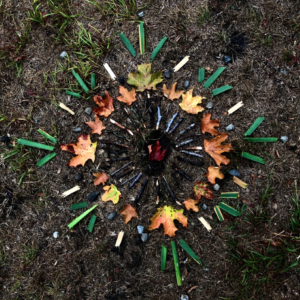
Nature mandala by Sophia Kaplan.
A mandala is a geometric figure that has radial, or rotational, symmetry. It is often in the form of a circle. A mandala has a strong central point, and the design flows – or radiates – from that center. In the Hindu or Buddhist tradition, they have a spiritual or religious meaning and are said to symbolize the universe. They are not all circular, but generally have a recognizable center from which the imagery flows. There are mandalas in many other traditions, as well, and they can represent wholeness, interconnectedness, the journey of life, tell a story or simply provide a close look at a facet of the universal experience. Contemporary mandalas have branched out from strict radial symmetry but will often evoke the theme of universal imagery or a closer look, even those made for the sake of art alone seem to have a deeper resonance. There are many examples of traditional and contemporary mandalas available with a quick search online.
Nature makes organic circular mandalas in snowflakes, spider webs, concentric ripples. The artist Andy Goldsworthy, known for his ephemeral works with entirely natural materials, creates evocative nature mandalas. Please watch this short video for inspiration:
[youtube width=”100%” height=”100%” autoplay=”true”]https://www.youtube.com/watch?v=LP_-P7ZcWZU[/youtube]
Mandalas from Nature
Create a nature mandala with found objects. Begin by looking closely – listening with your eyes – to the nature all around you outside. See the patterns already there. Look closely and identify the parts that make up a whole, or all the variety that inhabits a small space – say a square foot. Collect found objects from nature such as stones, leaves, blades of grass, seeds and pods, twigs, flowers or petals, bark – whatever is at hand and speaks to you! Using a flat surface out of the wind, begin by placing one of the objects in the center. Build out from there, seeking symmetry of design, or possibly to communicate an expression of the universe as described above. As you lay out the materials you may find it to be meditative; be aware of that experience as you create. Every mandala is beautiful – have fun!
When your mandala(s) is finished, take a picture and send to Michelle Sayles at msayles@clarku.edu, or tag your post on Instragram with the hashtag #ClarkLIN. The pictures and any caption you provide will be share through NEC’s social media.
